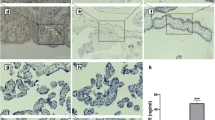Abstract
Objective
Wnt signaling has been identified as an essential pathway that can direct cell proliferation, migration, and tissue homeostasis. This study aimed to evaluate the role of Wnt signaling pathway in early-onset and late-onset preeclampsia (PE) using serum Dickkopf-1 and R-Spondin-3 glycoproteins.
Study design
A total of 80 pregnant women were included in this study. The patients were divided into three groups: (1) control (2) early-onset PE, and (3) late-onset PE. The serum levels of Dickkopf-1 and R-Spondin-3 were measured using an enzyme-linked immunosorbent assay.
Results
Of the 80 pregnant women enrolled in the study, 27 were control, 27 had early-onset PE, and 26 had late-onset PE. No differences were found in the maternal age, gravida, parity, and body mass index among the groups (P = 0.536, 0.230, 0.202, and 0.642, respectively). The serum level of Dickkopf-1 was significantly higher in the early-onset PE group compared with the control group (P = 0.006). The serum level of Dickkopf-1 was statistically similar in control group compared to late-onset PE group (P = 0.064). However, no significant difference was found in the serum levels of Dickkopf-1 and R-Spondin-3 between the early- and late-onset PE groups (P > 0.05). Additionally, the Spearman’s correlation analysis revealed a significant negative correlation between maternal serum level of Dickkopf-1 and maternal age (r = − 0.522, P = 0.005).
Conclusion
The increased serum level of Dickkopf-1 might be associated with the process of pathogenesis of early-onset PE. Further studies would elucidate their exact roles in the pathogenesis of PE.


Similar content being viewed by others
References
Ozdemir F, Tayyar AT, Acmaz G et al (2016) Comparison of blood and urine nephrin levels in preeclampsia and intrauterine growth retardation. Pak J Med Sci 32(1):40–43
Tayyar A, Tayyar AT, Abdülrezzak Ü et al (2012) The role of midtrimester amniotic fluid leptin and endothelin-1 levels in prediction of preeclampsia. J Turk Soc Obstet Gynecol 9(1):37–41
Chaiworapongsa T, Chaemsaithong P, Yeo L et al (2014) Pre-eclampsia part 1: current understanding of its pathophysiology. Nat Rev Nephrol 10(8):466–480
Steegers EA, von Dadelszen P, Duvekot JJ et al (2010) Pre-eclampsia. Lancet 376(9741):631–644
Zhang Z, Li H, Zhang L et al (2013) Differential expression of beta-catenin and Dickkopf-1 in the third trimester placentas from normal and preeclamptic pregnancies: a comparative study. Reprod Biol Endocrinol 4(11):17
Liu JT, Guo WB, Sun JY (2017) Serum Dickkopf-1 acts as a new biomarker in human breast cancer. Minerva Med 108(4):334–340
Zhao YP, Wang W, Wang XH, Xu Y, Wang Y, Dong ZF, Zhang JJ (2015) Downregulation of serum DKK-1 predicts poor prognosis in patients with papillary thyroid cancer. Genet Mol Res 14(4):18886–18894
Han SX, Zhou X, Sui X, He CC, Cai MJ, Ma JL, Zhu Q (2015) Serum dickkopf-1 is a novel serological biomarker for the diagnosis and prognosis of pancreatic cancer. Oncotarget 6(23):19907
Jiang T, Wang S, Huang L, Zhang S (2009) Clinical significance of serum DKK-1 in patients with gynecological cancer. Int J Gynecol Cancer 19(7):1177–1181
Jiang T, Huang L, Zhang S (2013) DKK-1 in serum as a clinical and prognostic factor in patients with cervical cancer. Int J Biol Markers 28(2):221–225
Mao B, Wu W, Davidson G et al (2002) Kremen proteins are Dickkopf receptors that regulate Wnt/β-catenin signalling. Nature 417(6889):664
Niehrs C (2006) Function and biological roles of the Dickkopf family of Wnt modulators. Oncogene 25(57):7469–7481
Wei Q, Yokota C, Semenov MV et al (2007) R-Spondin1 is a high affinity ligand for LRP6 and induces LRP6 phosphorylation and β-catenin signaling. J Biol Chem 282(21):15903–15911
Kim KA, Wagle M, Tran K et al (2008) R-Spondin family members regulate the Wnt pathway by a common mechanism. Mol Biol Cell 19(6):2588–2596
American College of O, Gynecologists, Task Force on Hypertension in P. Hypertension in pregnancy (2013) Report of the American College of Obstetricians and Gynecologists' Task Force on hypertension in pregnancy. Obstet Gynecol 122(5):1122–1131
Aksornphusitaphong A, Phupong V (2013) Risk factors of early and late onset pre-eclampsia. J Obstet Gynaecol Res 39(3):627–631
Redman CW, Staff AC (2015) Preeclampsia, biomarkers, syncytiotrophoblast stress, and placental capacity. Am J Obstet Gynecol 213(4 Suppl):S9e1–S9e11. https://doi.org/10.1016/j.ajog.2015.08.003 (PubMed PMID: 26428507)
Wang X, Zhang Z, Zeng X et al (2018) Wnt/β-catenin signaling pathway in severe preeclampsia. J Mol Histol 49(3):317–327
Cerdeira AS, Karumanchi SA (2012) Angiogenic factors in preeclampsia and related disorders. Cold Spring Harb Perspect Med 2(11):a006585
Valensise H, Vasapollo B, Gagliardi G et al (2018) Early and late preeclampsia: two different maternal hemodynamic states in the latent phase of the disease. Hypertension 52(5):873–880
von Dadelszen P, Magee LA, Roberts JM (2013) Subclassification of preeclampsia. Hypertens Pregnancy 22(2):143–148
Herzog EM, Eggink AJ, Reijnierse A et al (2017) Impact of early- and late-onset preeclampsia on features of placental and newborn vascular health. Placenta 49:72–79
Redman CW, Sargent IL, Staff AC (2014) IFPA Senior Award Lecture: making sense of pre-eclampsia - two placental causes of preeclampsia? Placenta 35(Suppl):S20–S25
Funding
This study did not receive any specific grant from any funding agency in the public, commercial, or not-for-profit sectors.
Author information
Authors and Affiliations
Contributions
ATT, AT, RK: project development. NFT, SK, ETY: data collection management and data analysis. MES, ES: manuscript writing and editing.
Corresponding author
Ethics declarations
Conflict of interest
The authors declare no conflicts of interest in regard to this study.
Additional information
Publisher's Note
Springer Nature remains neutral with regard to jurisdictional claims in published maps and institutional affiliations.
Rights and permissions
About this article
Cite this article
Tayyar, A.T., Karakus, R., Eraslan Sahin, M. et al. Wnt signaling pathway in early- and late-onset preeclampsia: evaluation with Dickkopf-1 and R-Spondin-3 glycoproteins. Arch Gynecol Obstet 299, 1551–1556 (2019). https://doi.org/10.1007/s00404-019-05126-8
Received:
Accepted:
Published:
Issue Date:
DOI: https://doi.org/10.1007/s00404-019-05126-8




